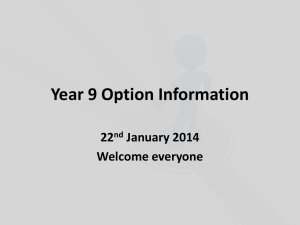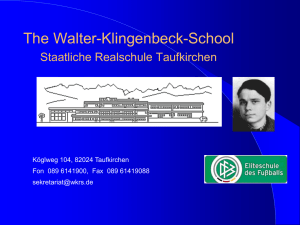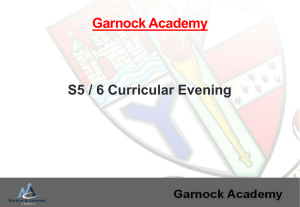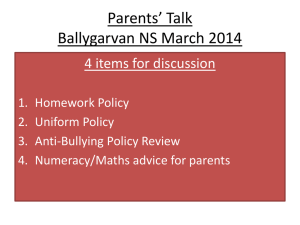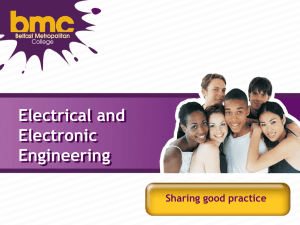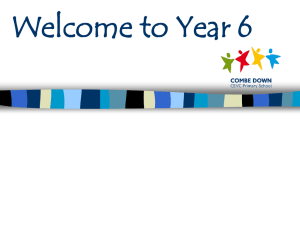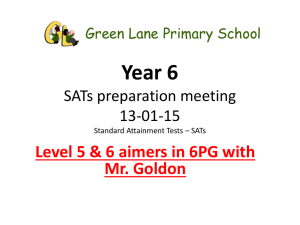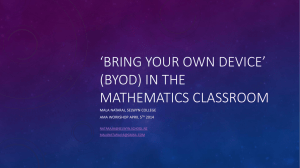Plenary Powerpoint - Auckland Mathematical Association
advertisement
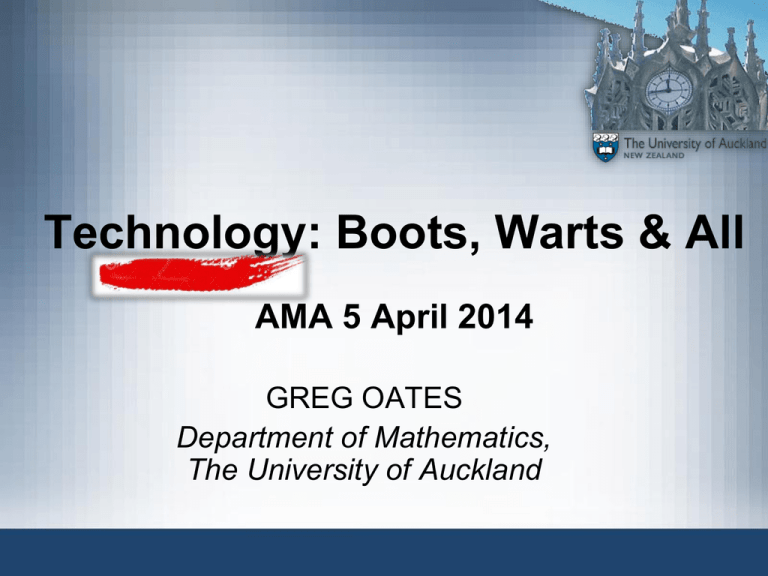
Technology: Boots, Warts & All AMA 5 April 2014 GREG OATES Department of Mathematics, The University of Auckland Complex, Inter-Related Factors affecting Successful Technology Integration “DOING Maths” VS “LEARNING Maths” VS “Delivery & Management” “Doing Maths” vs “Learning Maths” vs “Delivery & Management” Doing Maths: Technology as a tool-Research Mathematicians; Commercial & workplace, e.g. Excel, Matlab, Maple (past=slide rules, log tables etc) Learning Maths: Teachers, educators. Pedagogical Technical Knowledge (PTK); CAS-calculators; Internet & Software options; Geogebra, Desmos, Mathematics, Autograph, Wolfram Alpha, Khan Academy, BYOD Maths delivery & Management: Powerpoint, Tablet PC’s, data-projectors; Interactive Whiteboards; Learning Management systems (Onenote; Moodle; Cecil); Response systems (eg clickers) Learning Maths: PTK : The necessary knowledge of the principles and techniques required to teach mathematics using a given technology (Thomas & Hong, 2013). Mathematicians tend to have a “tool”=oriented view of technology, hence calculators seen as toys, limited awareness of learning opportunities, e.g. visualisation (rule of four); Exploration; skills building through repetitive exposure; (PTK), lessens arithmetic errors. Drijvers, 2012 Learning Maths PTK: Thomas & Hong, 2013 Boots & All: Explosion of options/possibilities; BYOD What’s Available? (not even touching on statistics) •Calculators: Scientific, Graphics, CAS, e.g. TI-nSpire –links between teacher & students; •Delivery: Data Projectors, Interactive Whiteboards, overhead data-cameras; Tablet PC’s, lecture recordings; •BYOD: Flipped Classrooms & Blended Learning: Huge range of options Doceri, Smartphones to make recordings; Internet access via tablets, computers, smartphones: Wolfram Alpha, Khan Academy, Freeware: e.g. Desmos, Geogebra; Math Way (need to purchase for full functionality); Other Commercial , eg Autograph •Access: now potentially less of problem? – many platforms work on Smartphones (apps); Have calculators lost their advantage of portability? Boots & All: UoA LUMOS Project Maths 102 •Lectures: Desmos, Wolfram Alpha, smart-phone response app; •Assignments: Promote active use of technology –e.g. marked correct if use technology (issues of how students show answers); ask for graphs using technology; •Group Tutorials: Tasks designed to be technology-active; BYOD; only one out of five tutorials in computer lab (Desmosstudents highly familiar even in just 4 weeks); Tutorial with Smartphone video as task; (total 10% of coursework) •Assessment: Test (10%) & five Skills quizzes (10 questions each quiz, worth 1%) done online using MathXL; Exam (60%) still traditional except CAS calculators permitted (fewer have); •Learning: Encouraged to use web; Learning support quizzes (with study plans) on MathXL Warts Rots Brain, Destroys Skills: This view is a distraction, non-productive: Ineffective use certainly can have this effect– this is the BIG CHALLENGE: How to promote, develop effective use –Instrumental Genesis? Access: Cost of many options still high, even freeware cant be accessed without a phone or computer; Often not allowed in summative assessment (e.g. exams); Which technology to choose? Syntax & Instrumentation: Can take a while for teachers & students to learn (advantage of Desmos is that it doent take long at all)–learning technology can get in the way of the mathematics; PTK: Growing challenge for teachers, especially with BYOD, how to keep up with the affordances, instrumentation of so many different technologies? Online Learning & Assessment Summer Project 2012/2013: UoA – Michael Walden & Simeon Pattenwise: Looked at wide variety of online learning & assessment platforms (not e.g. Math Way-primarily learning); Settled on MathXL (advantages described earlier); Technology–Active Assessment: They looked at a large number of questions traditionally asked in Maths 102 exams: Classified as Technology –Trivial; -Neutral, Active Trivial: (Does not imply the question is trivial) e.g. Determine the gradient & y-intercept of 5y + 3x - 2 =0. Even without technology, this is largely a routine procedural question. (Skemp’s instrumental vs relational understanding). How might we transform or ask such a question as technology-active? Example: Asking Technology-Active Questions Find 71 3 3 x3 dx 6 How can technology help? 4 Scientific calculator - limited to arithmetic value; GC - sketch a graph, 2 helps with visualisation; CAS - will just give answer (Wolfram Alpha, Geogebra, 0 2 4 TI-nSpire etc); Can also Show area under curve – calculate as move across. 6 8 Example: Asking Technology-Active Questions Suppose you know that the definite integral for a certain function f(x) between a and b equals 15, i.e. b a f ( x) dx 15 What can you say about the integral of f(x) + 4 between the same limits, i.e. f ( x) 4dx ? b a Thank You Promos: *MEU Post-Grad Courses: b.barton@auckland.ac.nz *Maths Olympiad: p.kane@auckland.ac.nz *Teacher Study Awards (close early June): Information meeting to be held at Epsom Campus – AMA to email.
